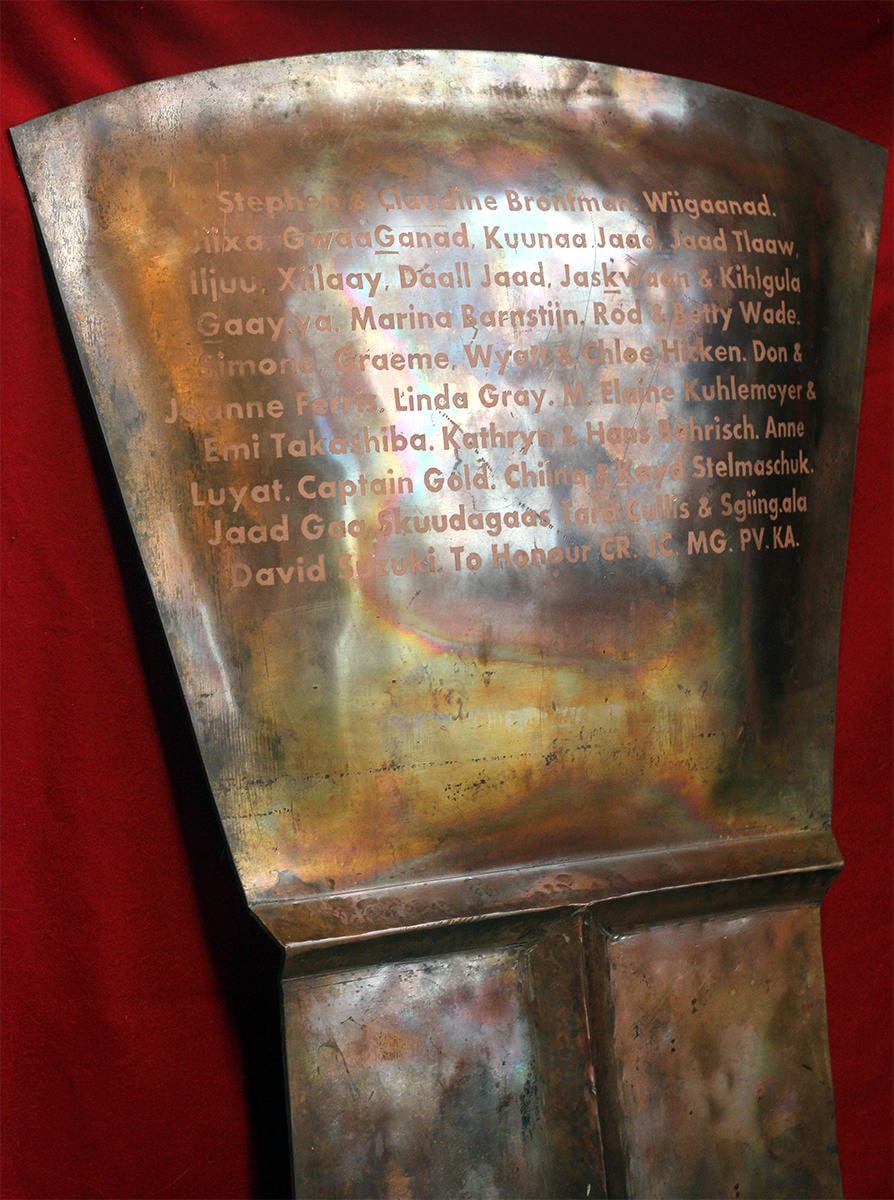Inside the Haida Gwaii Museum, the T’aaGuu SGaana (Supernatural Copper) shines as it gathers names.
The Haida copper is engraved with a growing list of supporters’ names — people who have donated significant money or time to a unique Haida language program that is building a whole community of new speakers.
Known as the Haida Gwaii MAP, or Mentor-Apprentice Program, it brings fluent Haida speakers together with dedicated learners who try doing all kinds of everyday things without speaking a word of English.
Working in small teams, they might sing, cook, tell stories, or play games, usually in the mentor’s home.
“The biggest thing is that you’re not in a classroom,” says Severn Cullis-Suzuki, who started learning Xaayda Kil when she moved to Haida Gwaii a dozen years ago and who has since been both an apprentice and an organizer of the program.
“You’re trying to create an immersion environment in the home, or outside — wherever the mentor wants to be.”
Haida Gwaii’s own mentor-apprentice program has its roots in one that started with the endangered Karuk language, in northern California.
Leanne Hinton, a linguistics professor, wrote a book about it together with a group of language activists and Julian Kang, a Karuk speaker.
Called How to Keep Your Language Alive — A Commonsense Approach to One-on-One Language Learning, it led to programs where one mentor and one apprentice spend 300 hours a year together, speaking in a homegrown, immersive way that is not unlike what a child would experience when learning a mother tongue.
Cullis-Suzuki said it’s an amazing book, not only for the immersion approach but also because it’s realistic about the time it takes to learn a language.
“It’s kind of like exercise,” she said. “If you work out once a month, it’s always going to be a bit painful and you’ll never really get ahead.”
“Language is similar. If you start working out every day, then it’s easy, and you can actually build your fitness.”
Along with fellow language learners Jaskwaan Bedard, Judson Brown, and Melody Gravekke, Cullis-Suzuki apprenticed for a year with a single fluent speaker, which is how the program is run by B.C.’s First Peoples’ Cultural Council.
When a group of local Haida language learners decided to launch their own mentor-apprentice program four years ago, they kept that one-to-one model, with three pairs of mentor-apprentices in Old Massett and another three in Skidegate.
But by year two, the program was just too popular. A total of 27 people signed up, every one of them ready to take on hundreds of hours of Haida-language learning.
“It was a huge change,” said Cullis-Suzuki, who credits the jump in demand not only to the apprenticeship program but also to SGaawaay K’uuna, the Haida language film Edge of the Knife.
Elders and learners on the MAP committee agreed that rather than turn applicants away, they would divide their funding so each apprentice could join in for three months each.
It was a shift in focus — one that made building a whole community of speakers and learners the number-one goal.
“Every language is so unique, in terms of its community, that to actually revitalize it is going to take a unique set of decisions and programs,” Cullis-Suzuki said.
As a sign of how that local approach is working, the program has now grown to 36 apprentices and 16 mentors, all working in small teams.
Helen Engelbert, the program coordinator for Haida Gwaii MAP, noted that it now involves speakers from 14 to over 70, and equal numbers of Massett and Skidegate speakers.
Many apprentices and mentors also take part in other Haida language programs, such as the Skidegate Language Nest where she starting learning Haida language with her young daughter.
“I think that’s good,” Engelbert said, speaking of the crossover between programs, and between speakers of both Haida Gwaii dialects.
“I could see it increasing, to create a larger language network where we’re all communicating and helping each other.”
Cullis-Suzuki agrees.
“Not long ago, there was some worry that we’d have to choose one dialect to survive this bottleneck,” she said.
“And I think now there’s a realization that back in the day, Haidas spoke or understood several different dialects… I think there’s more confidence that is the way forward, rather than having to choose.”
The first supporters’ names engraved on the T’aaGuu SGaana are Stephen and Claudine Bronfman — through their foundation, they donated key funding to get the Haida Gwaii mentor-apprentice program started.
The next name is Wiigaanad, which is held by Sid Crosby, who made the copper and gifted it to the language learners.
Dozens more names follow, and there is still room for more.
Donations to the Haida Gwaii MAP can be made through the Haida Gwaii Museum, a registered charity, and anyone who donates $500 in cash or in kind will have their name engraved as a shining example of Haida language support.
To donate write a cheque to the Haida Gwaii Museum. On the memo or accompanying letter specify the donation is for the Haida language program.
Mail to:
Haida Gwaii Mentor Apprentice Program
c/o Haida Gwaii Museum
PO Box 1373
Skidegate, BC
V0T1S1
